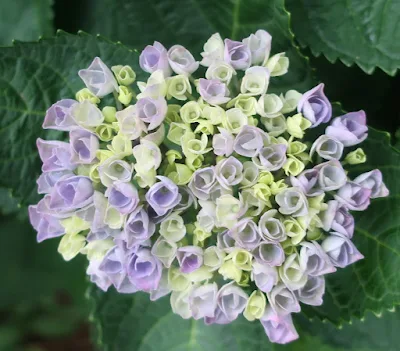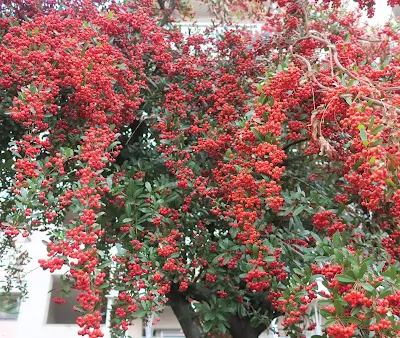Hi! I'm Kei Narujima. This is a blog about flowers/plants🌼and bugs🐛, and sometimes art and unique Japanese culture that make you smile or think (or so I hope)!! こんにちは。花や虫、そして時々日本の文化などについて書いてます😊。税務英語については https://zeimueigo.blogspot.com/ をご覧ください。
Two Quinces 木瓜と花梨
These are all Chinese quinces. The green ones are fruits of Chaenomeles speciosa and the yellow ones are Pseudocydonia sinensis. Both are in the Rosaceae family but they're different plants and so is the hardness of their peel. The yellow one's peel (Pseudocydonia sinensis) is harder than the green one's (Chaenomeles speciosa) although jam made from Pseudocydonia sinensis and Chaenomeles speciosa is both "sour" sweet that some find it not sweet enough and a little astringent.
Autumn Leaves 紅葉
The best season for autumn leaves in Tokyo is from late November to early December and leaves on some trees have started to change color. Many go to famous (and sometimes distant and busy) places to see fall leaves but you can enjoy autumn foliage here and there in Central Tokyo without being disturbed by crowds.
Princess Flowers (Pleroma Urvilleanum) シコンノボタン(紫紺野牡丹)
 |
| 2025/11/16 |
 |
| 2025/11/16 |
Purple Woodsorrel (Oxalis Purpurea) フヨウカタバミ(芙蓉酢漿草)
Purple woodsorrel (Oxalis purpurea) is native to South Africa. The plant came to Japan in the late 18th century and now can be found across Japan. Purple woodsorrel produces pink and white flowers from April to July in general but when warm from November to March, too. Its Japanese name is "fuyou katabami," which translates into "rose marrow woodsorrel" because of its resemblance to rose marrow.
 |
| 2025/11/16 |
 |
| 2025/11/16 |
Wax-Leaf Privet (Ligustrum Japonicum) ネズミモチ(鼠糯)
Japanese Laurel (Aucuba Japonica) 青木(アオキ)
Henbit Deadnettle (Lamium Amplexicaule) ホトケノザ(仏の座)
Henbit deadnettle (Lamium amplexicaule) can be found across Japan. The plant is supposed to produce flowers from March to June but as you can see in these photos, it has flowers throughout the year but summer. The flowers have a unique shape with spots, which plays an important role to attract pollinators, like bees. Its Japanese name means "lotus seat for Buddha." How lovely would it be to sit on it!😊
Ginkgo (Ginkgo Biloba) イチョウ(銀杏)
 |
| 2025/11/10 |
Dawn Redwood (Metasequoia Glyptostroboides) メタセコイア
Some plants are aesthetically pleasing throughout the year and dawn redwood trees (Metasequoia glyptostroboides) are one of them. Last autumn, their leaves created a gorgeous view (scroll down). In spring, their small cones made me chuckle and the leaves created a magnificent, fresh green view. And yesterday, I found a tree with fruits, which look like matcha chocolates.
Ring-Cupped Oak (Quercus Glauca) アラカシ(粗樫)
Ring-cupped oak or Japanese blue oak trees (Quercus glauca) can be found almost across Japan. They produce acorns from October to November and the acorns are not only fed on by insects and birds but were eaten by people as a famine food in Japan. Oak trees are usually known for the acorns but ring-cupped oak trees produce beautiful cylindrical flowers (6th and 7th photos) and red shoots (5th photo), which look like the heads of Pteranodon (to me), from April to May.
 |
| 2025/11/8 |
 |
| 2025/11/8 |
Chinese Quince (Pseudocydonia Sinensis) カリン(花梨)
英語の後に日本語が続きます。
The Chinese quince (Pseudocydonia sinensis) is native to China but now can be found across Japan. The plant is known for the fruits but enjoyable throughout the year. Its pink flowers are pretty, jam made from the fruits is yummy, and the autumn leaves are so colorfully beautiful.
Single-Flowered White Sasanqua Camellia 一重の白い山茶花
Single flowered camellia sasanquas are less gorgeous than but as beautiful as double flowered ones and are easier to access for insects.
 |
| 2025/11/8 |
 |
| 2025/11/8 |
Hydrangea Turning Red in Autumn 秋色紫陽花
英語の後に日本語が続きます。
The hydrangea was pale pink, blue, and green in early summer. So, its color change to red toward autumn surprises me (3rd photo). Such a color change occurs because of increasing anthocyanin due to a change in the temperature and/or the amount of ultraviolet radiation. For whatever the reason, it's just amazing.
 |
| 2025/6/8 |
 |
| 2025/5/29 |
 |
| 2025/11/1 |
Sacred Bamboo (Nandina Domestica) ナンテン(南天)
The sacred bamboo (Nandina domestica) is native to China and came to Japan before the 16th century and now found across Japan. The plant is called "南天 (nanten)" in Japanese, which translates to South India, because it was believed to have come from there. The term "nanten," however, can also be written as "難転," which translates into "a blessing in disguise" and therefore the sacred bamboo is used for Japanese New Year decorations.
Pale Grass Blue (Pseudozizeeria Maha) 大和小灰蝶(ヤマトシジミ)
 |
| 2025/11/2 |
Common Straight Swift (Parnara guttata) イチモンジセセリ(一文字挵)
Butterflies usually fold wings when resting while moths with open wings. The common straight swift (Parnara guttata) is a butterfly but sometimes rests with open wings to absorb the warmth of the sun, thanks to which I've learned that their back is green (in the 1st and 2nd photos). The 3rd photo is of an ant carrying a dead common straight swift.
 |
| 2025/11/2 |
 |
| 2025/10/13 |
 |
| 2025/10/13 |
Pink and White Marbled Sasanqua Camellia 源平咲きの山茶花
Sasanqua camellias (Camellia sasanqua) are native to Japan and can be found across Japan. The plant produces white, pink, and red flowers from October to December, earlier than Japanese camellia (Camellia japonica), which is one of the differences between the two camellias.
- Pink and white marble colored Japanese apricot
- Red and white marble colored flowering peach
- Pink and white variegated bush clover
 |
| 2025/11/1 |
Winter Cherry (Cerasus x Parvifolia/Cerasus Subhirtella) フユザクラ(冬桜)
英語の後に日本語が続きます。
The winter cherry (Cerasus x parvifolia 'Fuyu-zakura') is a crossbreed of Cerasus incisa and Cerasus speciosa. The cherry differs from other cherry trees in its time of blossoming. The winter cherry blossoms twice a year, in early April and in winter (from October to December), because of which the cherry tree is called "winter cherry" in Japan.
It has another name "koba zakura," which translates into "small leaf cherry" for its relatively smaller leaves. The winter cherry blossoms are less gorgeous but stay longer than other cherry blossoms, which generally fall in two weeks.
Some say when passing by a winter cherry tree that it's silly, blooming out of season but at such times I always say in my mind "It's you who are silly😝."
 |
| 2021/11/25 |
 |
| 2022/12/9 |
Firethorn Tree (Pyracantha) ピラカンサ(常盤山査子)
The firethorn or pyracantha is native to an area extending from Southwest Europe east to Southeast Asia and can be found across Japan. The plant produces beautiful white flowers from April to May and red, orange, and yellow fruits from November to January.
White-Banded Hunter Hawkmoth (Theretra Oldenlandiae) セスジスズメ(背筋雀)
I've seen the black caterpillars in autumn for the last several years. They're caterpillars of the impatiens hawkmoth or white-banded hunter hawkmoth and can be found across Japan. The caterpillars are (kind of) cute but the adults are cool, looking like fighter aircrafts.
Two Quinces 木瓜と花梨
英語の後に日本語が続きます。 These are all Chinese quinces. The green ones are fruits of Chaenomeles speciosa and the yellow ones are Pseudocydonia sinens...

-
英語の後に日本語が続きます。 I read "A Pale View of Hills" by Kazuo Ishiguro a few years ago. The book was my second Ishiguro's book after...
-
Japanese follows English. 英語の後に日本語が続きます。 Is he being boiled to death? (This is a revised version of the story originally posted on Se...









.JPG)






















